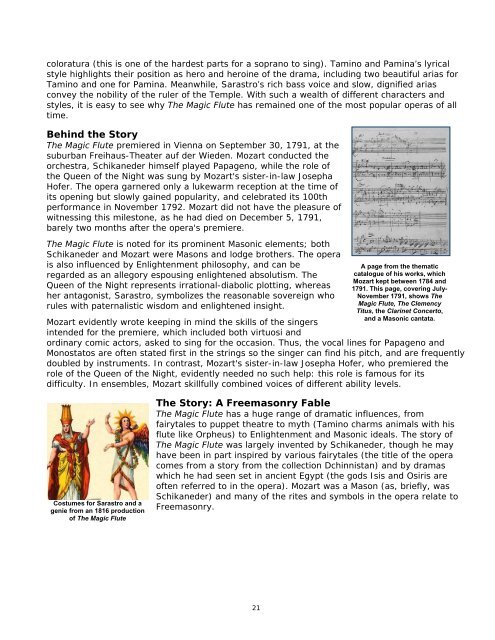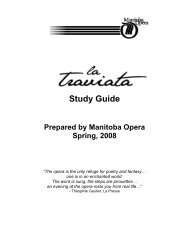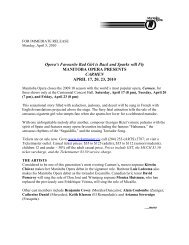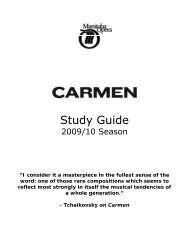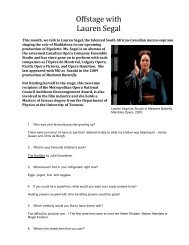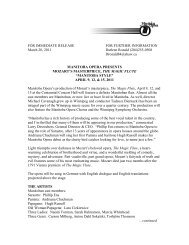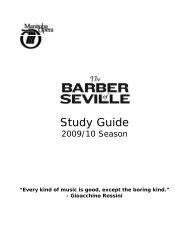The Magic Flute Study Guide - Manitoba Opera
The Magic Flute Study Guide - Manitoba Opera
The Magic Flute Study Guide - Manitoba Opera
You also want an ePaper? Increase the reach of your titles
YUMPU automatically turns print PDFs into web optimized ePapers that Google loves.
coloratura (this is one of the hardest parts for a soprano to sing). Tamino and Pamina’s lyrical<br />
style highlights their position as hero and heroine of the drama, including two beautiful arias for<br />
Tamino and one for Pamina. Meanwhile, Sarastro’s rich bass voice and slow, dignified arias<br />
convey the nobility of the ruler of the Temple. With such a wealth of different characters and<br />
styles, it is easy to see why <strong>The</strong> <strong>Magic</strong> <strong>Flute</strong> has remained one of the most popular operas of all<br />
time.<br />
Behind the Story<br />
<strong>The</strong> <strong>Magic</strong> <strong>Flute</strong> premiered in Vienna on September 30, 1791, at the<br />
suburban Freihaus-<strong>The</strong>ater auf der Wieden. Mozart conducted the<br />
orchestra, Schikaneder himself played Papageno, while the role of<br />
the Queen of the Night was sung by Mozart's sister-in-law Josepha<br />
Hofer. <strong>The</strong> opera garnered only a lukewarm reception at the time of<br />
its opening but slowly gained popularity, and celebrated its 100th<br />
performance in November 1792. Mozart did not have the pleasure of<br />
witnessing this milestone, as he had died on December 5, 1791,<br />
barely two months after the opera's premiere.<br />
<strong>The</strong> <strong>Magic</strong> <strong>Flute</strong> is noted for its prominent Masonic elements; both<br />
Schikaneder and Mozart were Masons and lodge brothers. <strong>The</strong> opera<br />
is also influenced by Enlightenment philosophy, and can be<br />
regarded as an allegory espousing enlightened absolutism. <strong>The</strong><br />
Queen of the Night represents irrational-diabolic plotting, whereas<br />
her antagonist, Sarastro, symbolizes the reasonable sovereign who<br />
rules with paternalistic wisdom and enlightened insight.<br />
Mozart evidently wrote keeping in mind the skills of the singers<br />
intended for the premiere, which included both virtuosi and<br />
ordinary comic actors, asked to sing for the occasion. Thus, the vocal lines for Papageno and<br />
Monostatos are often stated first in the strings so the singer can find his pitch, and are frequently<br />
doubled by instruments. In contrast, Mozart's sister-in-law Josepha Hofer, who premiered the<br />
role of the Queen of the Night, evidently needed no such help: this role is famous for its<br />
difficulty. In ensembles, Mozart skillfully combined voices of different ability levels.<br />
Costumes for Sarastro and a<br />
genie from an 1816 production<br />
of <strong>The</strong> <strong>Magic</strong> <strong>Flute</strong><br />
<strong>The</strong> Story: A Freemasonry Fable<br />
<strong>The</strong> <strong>Magic</strong> <strong>Flute</strong> has a huge range of dramatic influences, from<br />
fairytales to puppet theatre to myth (Tamino charms animals with his<br />
flute like Orpheus) to Enlightenment and Masonic ideals. <strong>The</strong> story of<br />
<strong>The</strong> <strong>Magic</strong> <strong>Flute</strong> was largely invented by Schikaneder, though he may<br />
have been in part inspired by various fairytales (the title of the opera<br />
comes from a story from the collection Dchinnistan) and by dramas<br />
which he had seen set in ancient Egypt (the gods Isis and Osiris are<br />
often referred to in the opera). Mozart was a Mason (as, briefly, was<br />
Schikaneder) and many of the rites and symbols in the opera relate to<br />
Freemasonry.<br />
21<br />
A page from the thematic<br />
catalogue of his works, which<br />
Mozart kept between 1784 and<br />
1791. This page, covering July-<br />
November 1791, shows <strong>The</strong><br />
<strong>Magic</strong> <strong>Flute</strong>, <strong>The</strong> Clemency<br />
Titus, the Clarinet Concerto,<br />
and a Masonic cantata.


